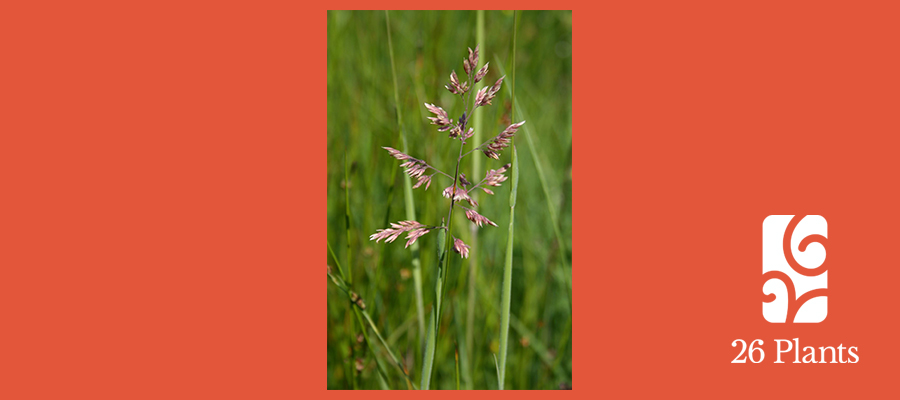Yorkshire Fog
Holcus Ianatus
Irene Lofthouse

Pink Striped Pyjamas
Pink striped pyjamas
snuggle within downy
grey-green dressing gowns
sharing growing dormitories,
slumbering in repose
dreaming into life
a chilling earth
reminding creamy heads
to wake, emerge
blushing in damp beds
to early sun
heads breeze-nodding
softly, misting fields
meadows, waste ground
with purple haze,
favourite of southern
Small Skippers, indicator
of poor soil, drainage,
stabiliser of land.
This Yorkshire Fog’s
spread across continents
seeds surviving droughts,
hot summers, its growth
invading natives’ habitats
choking wetlands
threatening biodiversity
where severe frosts rarely visit.
A choice – trampling or puddling –
creating impervious mud blankets
to smother, suffocate, dying
fading pink striped pyjamas.
Yorkshire fog. Childhood constant, a smog that enveloped Bradford from mills, trains, coal fires. I never associated it with the green of grass, fields, countryside. In fact, the name may come from that very smog as the Woodland Trust notes: ‘It is said that Yorkshire fog grass was given the name because, from a distance, it resembles the smoke that once billowed from the chimneys of northern factories.’ However there are other names – velvet grass, tufted grass, meadow soft grass in the UK and across the world – but no definitive reference to the first naming as Yorkshire Fog.
Holcus Ianatus. The Latin Ianatus means woolly, describing the texture of the leaves. These are grey/green, but peeling back reveals the pink/purple stripped stem at the base – hence Pink Stripped Pyjamas appellation. However, there is a lot of variation in its morphology and growth habit, which made identification quite tricky as I trawled images, then fields and woodlands close to me looking for examples. Some of the flower heads are dense and thick, where others are sparse, and the purpling of the heads happens from May to August.
The grass spreads from shoots and roots, leaves creating circles of prostrate rosettes like wheel spokes that form a blanket on the soil surface which suffocate any other plant growth. This, along with the large amount of seed it can produce (up to 240,00 depending on time of emergence) makes it a rapid coloniser, especially of disturbed ground, and a crop contaminator. Its use as a land stabiliser is a double-edged sword.
Although in general it’s not seen as a food crop, the young shoots have a fairly high mineral content, are easy to digest and will be grazed by sheep and stock animals if nothing else is available. On a more positive note, it’s a food source for the Speckled Wood butterfly in Southern Britain, the Small Skipper caterpillar here, Europe, North Africa and Middle East. There are conflicting views whether the Essex Skipper uses the plant (but good news that the butterfly has doubled in the last decade).
Like so many plants transported to other lands, Yorkshire Fog has become a problem: it threatens rare Tarengo and Gaping Leek orchids in Australia, as well as wetland biodiversity; it’s a rampant invasive weed in North America; agricultural forums discuss in depth how to deal with it’s spread and management.
Walking through fields nearby, the rippling purpleness presents a buccolic picture of the past in the present, belying the issues that Yorkshire Fog has spread into the future.
Image: Photo by Franz Xaver, under Creative Commons license
